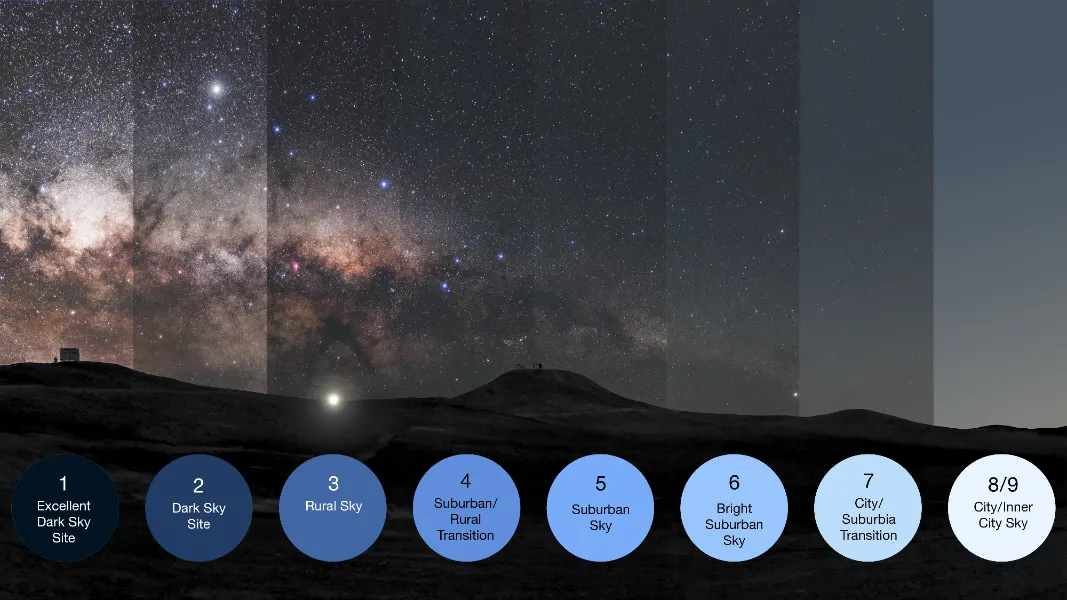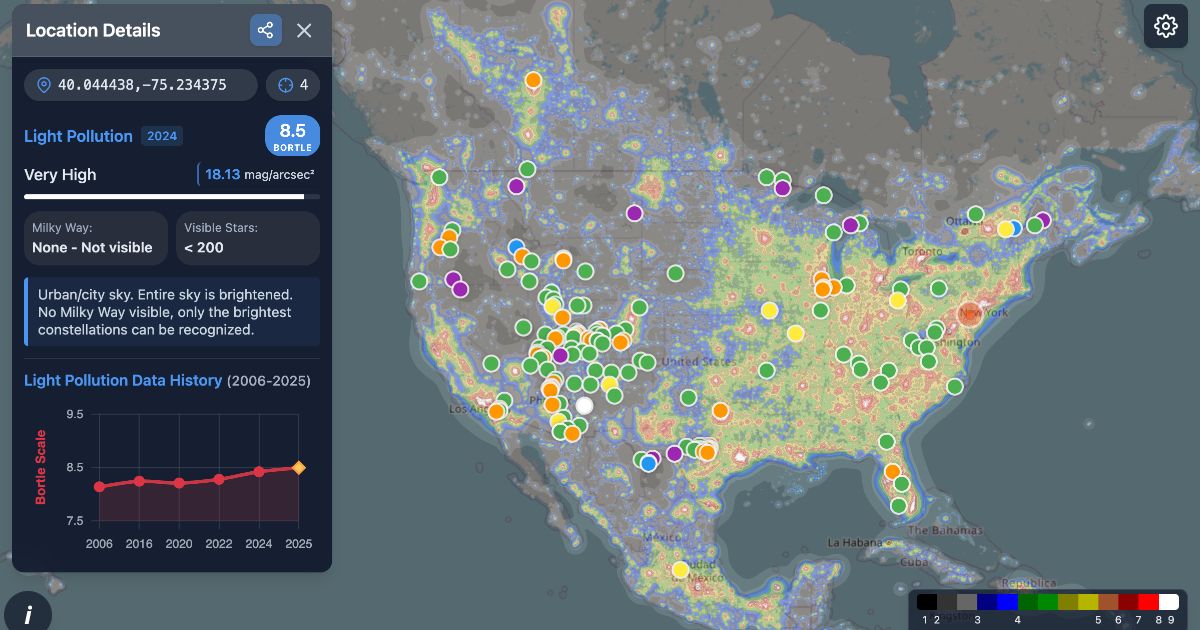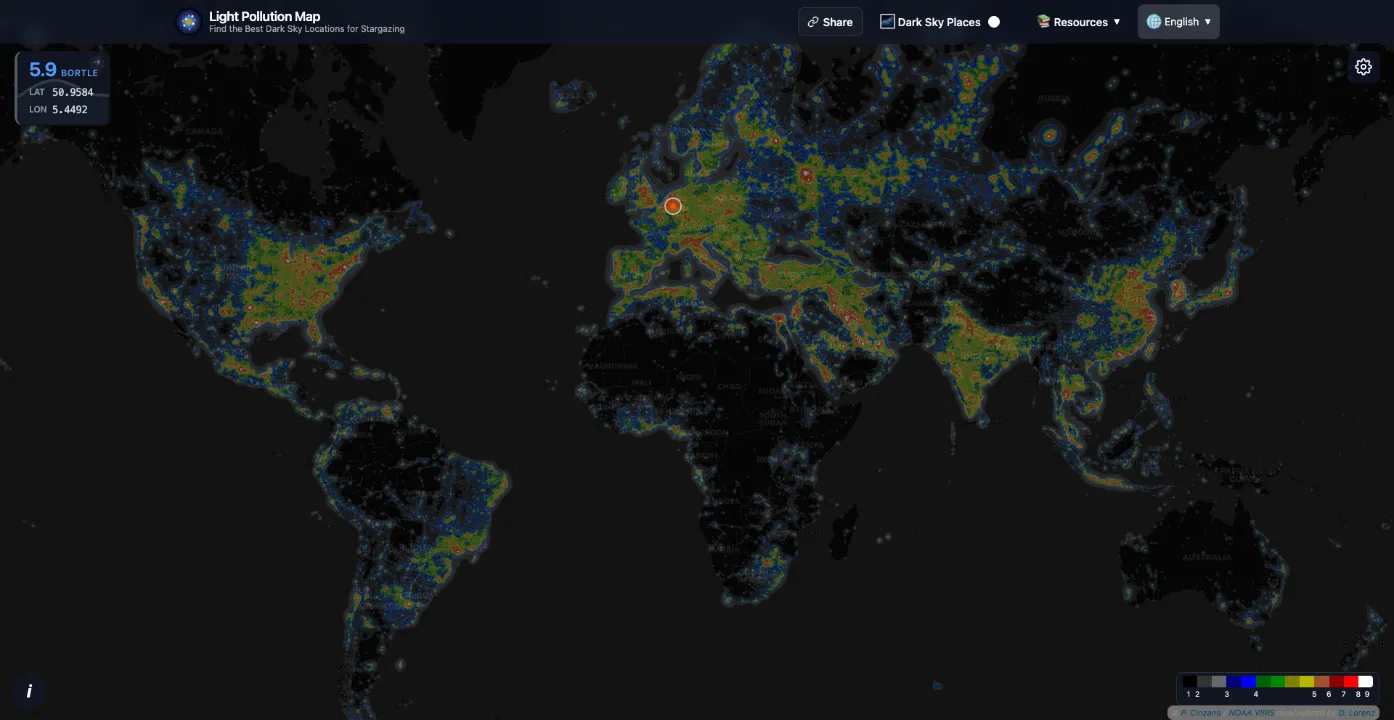Dark Sky Locations
Map Controls
Search Location
Base Map
Light Pollution Layer
Day/Night Terminator
Dark Sky Locations
Search Location
Searching...
Location Details
Share This Map
Help raise awareness about light pollution! Share this map with friends and family to show how light pollution affects our night sky.
Light Pollution 2024
Light Pollution Trends (2006-2024)
Analyzing trends...
2024 Prediction
Natural night sky
Rural sky
Suburban sky
Urban sky
City core
Light Pollution Map FAQ
Is this website updated in real-time? How often is the data refreshed?
The website's data is updated periodically. The base light pollution data comes from NOAA's VIIRS data, which is typically updated annually to ensure comprehensive coverage and accuracy. We plan to incorporate additional data sources in the future.
What does "Bortle Scale" on the map mean? How should I interpret it?

© ESO/P. Horálek, M. Wallner - Representation of the Bortle scale
The Bortle Scale is a standard way to measure how dark the night sky is. It's useful for stargazing, ranging from Class 1 (pitch black) to Class 9 (heavily light-polluted). Lower numbers mean more stars visible. Our map uses color codes to help you quickly see how dark the sky is at any location.
What is "SQM" and how does it differ from the Bortle Scale?
SQM (Sky Quality Meter) shows night sky brightness in precise numbers, measured in magnitudes per arcsecond squared (mag/arcsec²). Higher values mean darker skies. While the Bortle Scale is more of a category system, SQM gives exact values, and can be converted to Bortle classes for easier understanding.
How can I find the best stargazing locations near me?

US light pollution map with dark sky places and stargazing locations
Our system analyzes your approximate location based on your IP address and automatically displays the Bortle class for that area. You can also search for specific addresses or manually explore the map to discover optimal stargazing spots in other regions.
Can the map show aurora activity? Are there recommended regions for aurora viewing?
We're in the process of integrating real-time aurora prediction tools (such as KP index) and observation layers into our map. This will help users in high-latitude regions like Northern Europe, Canada, and Alaska track and pursue aurora sightings.
Can I use this to plan Milky Way photography sessions?
Absolutely! The map combines light pollution levels with geographical data to help you locate ideal spots for Milky Way observation and photography. We're also planning to add features like Milky Way rise times and direction to support astrophotographers in efficiently planning their shoots.
Is this map optimized for mobile use? Is there an app version?
This website is fully optimized for mobile devices, so it works smoothly anywhere. You can also check sky conditions and light pollution using the StargazingHub App.
Which countries or regions are supported? Is it a global map?

Global light pollution map showing worldwide distribution of artificial light at night
Yes, lightpollutionmap.app shows light pollution worldwide, covering most countries and regions. It's great for stargazers and travelers. We also offer a Chinese version at Darkmap.cn.
What's the source of the light pollution data? Is it reliable?
Our data mainly comes from NOAA's VIIRS, with the map created by David Lorenz. We'll soon add data from the World Atlas 2015, based on research by Falchi et al.
How can I share a specific location on the map?
You can go directly to a specific spot by adding coordinates to the URL: https://lightpollutionmap.app/?lat=25.3125&lng=-80.6875&zoom=8
Use this to share locations or bookmark your favorite stargazing places. Just change the latitude (lat), longitude (lng), and zoom level.
Is there a user community or feature for uploading observation reports?
We're planning to build a community for stargazing enthusiasts where users can upload field observation reports, photos, and suggestions. This will enrich our map data and allow users to share their observation experiences.
Is there a fee for using this service? What premium features are available?
Our website's basic features are permanently free to use. Currently, we don't have plans for a membership program, so you can use our light pollution map with confidence.
How can beginners get started with night sky observation? How does the map help?
The map helps stargazers quickly find suitable observation locations nearby and provides Bortle class information along with basic astronomical guidance. We plan to expand beginner tutorials and observation recommendations in the future to help you easily start your stargazing journey.
How can I reduce the impact of light pollution on astronomical observations?
To minimize the effects of light pollution on your astronomical observations, we recommend using Light Pollution Filters. These specialized filters can significantly improve visibility by blocking specific wavelengths of artificial light while allowing starlight to pass through. For quality options, check out Optolong Light Pollution Filters, which offer solutions for both visual observation and astrophotography.
Feedback
Last Updated: